
The roles and structures of libraries are changing as digital humanities research and projects increase. A panel of experts met at Midwinter to discuss the opportunities this growing field presents for libraries to engage with academic faculty and increase the value of librarians on campus.
The majority of attendees said they worked in the humanities, but the exact definition of digital humanities is still nebulous. Kathy Rosa, director of ALA’s Office for Research and Statistics, offered a basic definition—digital tools and technology applied to the traditional objects and methods of the humanities. She also pointed to Jason Heppler’s What is Digital Humanities? project, which offers a different, randomly selected definition each time the page loads, compiled from hundreds of online definitions, making it a digital humanities project about digital humanities.
Rosa shared results of a recent American Libraries/Gale Cengage survey of faculty and librarians about digital humanities in libraries.
The most common services faculty want include help with project management, primary source content, digital tools, and outreach and marketing.
For librarians, Rosa noted that having a dedicated digital humanities center is important, and most believe that a digital humanities librarian should be a full-fledged collaborator and participant with faculty.
However, about half of librarians describe their digital humanities services as ad hoc. One in five librarians say they provide no digital humanities services, and nine out of 10 say their library has no written statement of support for digital humanities, so it is not part of the budget.
David Seaman, dean of libraries and university librarian at Syracuse University, brought the perspective of a large research library to the panel.
While he agreed that “digital humanities” is an imprecise term, he didn’t think that was a bad thing. The flexibility of digital humanities means different institutions and projects can take it in different directions. Seaman himself has been doing work on such projects for a long time, even if not under the digital humanities banner. He described the work as inherently collaborative, remarking, “It’s extremely difficult to be a lone digital humanist.”
Seaman said the increased visibility of digital humanities means he is finding it easier now to explain it to alumni, making it easier to raise funds because he has projects to point to. He can hire new faculty with digital humanities skills and offer new courses with digital humanities support.
All of the activity shows the need to make digital humanities programmatic, he said. There are also space implications—whether or not creating a physical digital humanities center makes sense, digital humanities scholarship services will exist. Project management support and legal issues will be just as relevant to the sciences as to the humanities.
One challenge he sees is the role of evaluating this work for tenure. “It’s not unwillingness to do it, just bafflement. How do you talk about the scholarly impact of something with five collaborators that’s web-based?”
Thomas Padilla, digital scholarship librarian at Michigan State University Libraries in East Lansing, said he rejects the “hack/yack” dichotomy of digital humanities—that is, that the field is divided into those who deal with coding and those who deal with theory. Both camps require access to data and sharing of data.
He mentioned the recent release of almost 200,000 images from the New York Public Library to the public domain as a great model for library/faculty engagement. When collections are optimally usable and transparent, librarians are allowed to play a more active role (for example, using their copyright or metadata expertise).
Stephanie Orphan, director of publisher relations for Portico, discussed some of the challenges surrounded the long-term preservation of digital content. Portico works with publishers to preserve e-journals and ebooks and provides access to supporting libraries.
West Virginia University’s Dean of Libraries Jon Cawthorne asked, “What actions are libraries taking to adapt to user needs?” Organizations within libraries, such as a university press, should be structured to support digital humanities partnerships, he said.

